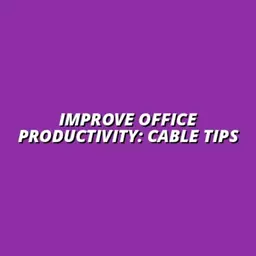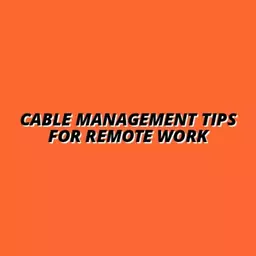Use Surge Protectors
Always use surge protectors to safeguard your electronic devices from power surges.

Did you know that nearly 30% of home office accidents are caused by electrical hazards? Ensuring electrical safety isn't just about compliance; it's key to creating a productive workspace. Here's what you can learn about maintaining a safe work environment at home.
Here's a quick overview of essential electrical safety practices to ensure a safe home office environment.
Always use surge protectors to safeguard your electronic devices from power surges.
Check electrical cords for wear and tear to prevent potential hazards.
Never overload outlets; use power strips wisely to distribute power safely.
Install Ground Fault Circuit Interrupters in moisture-prone areas for added safety.
Ensure compliance with local electrical codes to prevent hazards and ensure safety.
As more people shift to working from home, ensuring electrical safety in home offices has never been more critical. A safe workspace not only boosts productivity but also minimizes risks associated with electrical hazards. It’s essential to create an environment that allows you to focus on your work, knowing that your setup is both efficient and secure.
When I think about electrical safety, I often remember my early days in workspace optimization. I witnessed firsthand how improper setups can lead to accidents, reminding me of the importance of reliable electrical solutions. This is why I’m passionate about empowering individuals and organizations through our offerings at Power Tidy Workspace Lab, designed specifically to enhance safety in modern workspaces.
Electrical safety is vital for a few key reasons. Firstly, it protects your valuable electronic devices from damage due to power surges or faults. Secondly, it ensures your personal safety and the safety of anyone who might use your workspace. Lastly, a safe environment fosters improved productivity, allowing you to work without distractions or worries.
Consider this: a well-organized and safe home office can positively affect your mental state. When everything is in order, including your power management, it helps reduce stress. That’s why I continuously advocate for top-quality under-desk power solutions, which can make a significant difference!
Identifying potential electrical hazards in your home office is the first step in creating a safe workspace. Here are some common issues I’ve encountered that you should watch out for:
These hazards can lead to serious risks, and it's crucial to address them promptly. Implementing safe practices and utilizing high-quality products from Power Tidy Workspace Lab can help mitigate these risks effectively.
Poor wiring can have severe consequences, not just for the equipment but also for your safety. For instance, improperly installed wiring can cause short circuits, leading to fire hazards or equipment failure. Imagine working on a critical project, and suddenly your power goes out due to faulty wiring—frustrating, right?
💡 Mounting power strips safely and cleanly? Get our guide to under-desk power that’s neat and safe. 👉 Read the Under-Desk Power Guide
Moreover, poor wiring can also affect the efficiency of your devices, causing them to wear out faster. Keeping up with safe wiring standards is essential to ensure a reliable and safe workspace. By investing in quality under-desk power solutions, you’re not just improving aesthetics; you’re also safeguarding your work environment!
Before we proceed further, let's address some frequently asked questions about electrical safety to ensure we're all on the same page.
Here's a brief recap of the key points discussed so far:
As we wrap up our discussion on electrical safety, it's essential to highlight the key wiring standards and best practices that ensure a safe home office environment. By adhering to these guidelines, you can minimize risks and create a productive workspace. Remember, safety should always be your top priority!
Here’s a quick recap of the essential electrical safety guidelines you should keep in mind:
Creating a safe home office environment goes beyond just having the right equipment. It's about ensuring that every aspect of your electrical setup is optimized for safety and efficiency. At Power Tidy Workspace Lab, we believe that a tidy and organized workspace not only boosts productivity but also significantly reduces the risk of electrical hazards.
As you consider your workspace, ask yourself: Are there any potential hazards lurking in your setup? Addressing these concerns proactively can save you from costly accidents down the road. Regular evaluations and updates to your workspace can make all the difference!
Understanding electrical load calculation is key to preventing overloads in your home office. It’s about knowing how much power your devices require and ensuring that your circuits can handle it. Here’s a simple way to get started:
By following these steps, you can avoid potential issues and ensure that your workspace remains safe and efficient. If you have questions about your calculations, don’t hesitate to reach out for professional advice or check resources like those provided by local electrical codes!
Now that we've covered the fundamentals, I encourage you to take a closer look at your home office wiring. Are you meeting the necessary safety standards? Evaluating your setup can reveal areas that need improvement and help you create a safer work environment.
Consider turning this into a regular practice. Just like you maintain your devices, your electrical setup deserves the same attention. Safety is an ongoing process, and a little effort goes a long way!
To enhance your knowledge of electrical safety, there are many resources available. Here are a few I recommend:
These resources can empower you with the knowledge you need to create the safest workspace possible. Knowledge is power, after all!
Finally, maintaining your electrical setup is crucial. Just as you would regularly check the health of your devices, the same goes for your wiring. Consider scheduling regular inspections, replacing worn cords, and upgrading equipment as necessary.
At Power Tidy Workspace Lab, we understand the importance of a tidy, safe workspace. By committing to consistent maintenance, you’ll not only extend the life of your electrical components but also ensure that your home office remains a productive and safe haven!
Here is a quick recap of the important points discussed in the article:
Improve Office Productivity: Cable Tips

Did you know that a cluttered desk can drastically reduce your productivity? Effective under desk ca
Cable Management Tips for Remote Work

Did you know that a cluttered workspace can lead to a significant drop in productivity? The way we m
Improve Office Productivity: Cable Tips
Hide Cables Under Your Desk
Cable Management Tips for Remote Work
Streamlined Cable Management Solutions
Enhancing Safety Through Cable Management